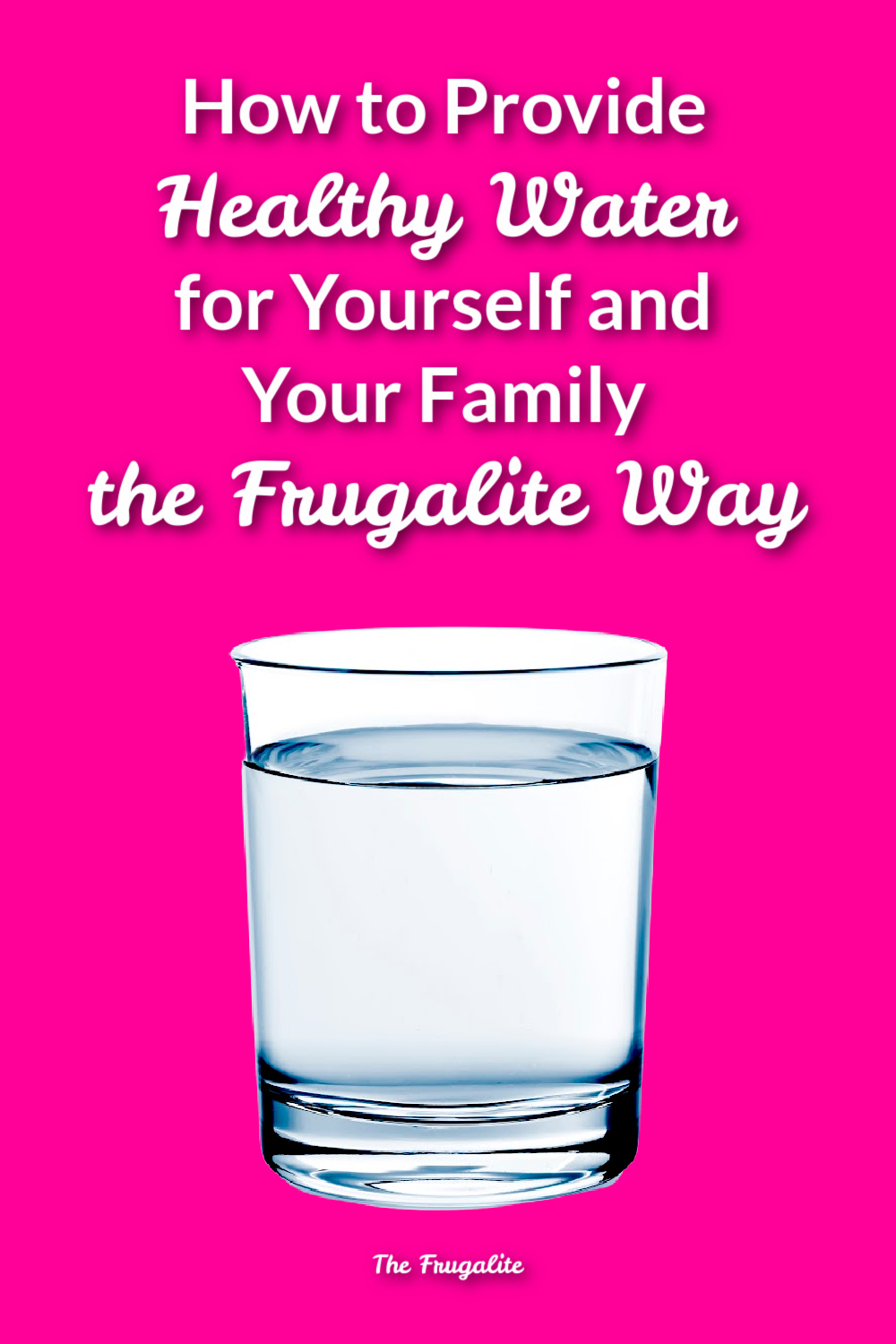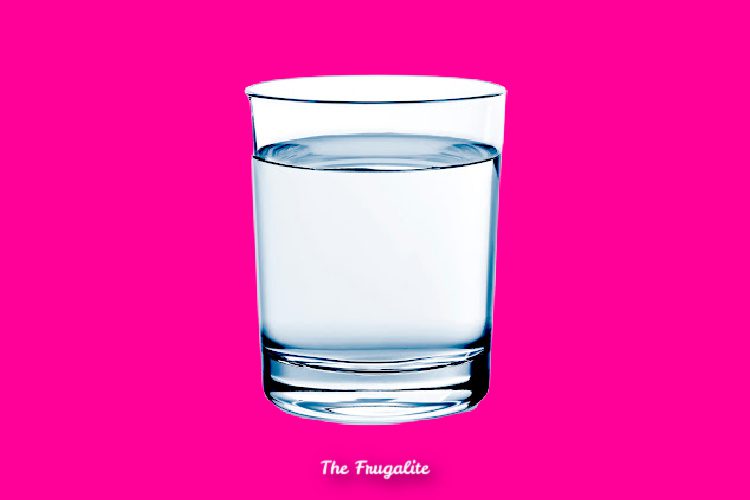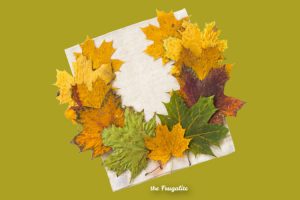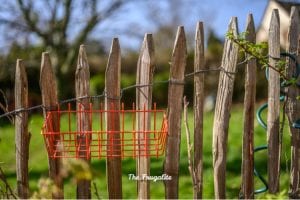(Psst: The FTC wants me to remind you that this website contains affiliate links. That means if you make a purchase from a link you click on, I might receive a small commission. This does not increase the price you’ll pay for that item nor does it decrease the awesomeness of the item. ~ Daisy)
Water is the most basic and most often overlooked commodity of all. In many countries, we turn on a faucet, and water flows as much as we need. With large parts of the United States in drought and water in the cities being of questionable quality, it seems prudent to give this matter more consideration. How do we provide healthy water for ourselves and our families, the Frugalite way?
The Faucet, Maybe
Turn on your kitchen faucet. Does the water smell and taste good, or is there a color or odor? Some impurities such as lead and other heavy metals have neither. They flow out of your faucet and into your food without leaving a trace. Ask the people in Flint, Michigan, how long it took to realize there was lead in their water. When I receive my annual report from the local water utility, lead levels are listed as “within acceptable range.” Really? There are many other toxic substances in my city’s water, but no worries, they’re all within acceptable levels. Right. For a peek at things that are also “acceptable” in tap water, read this article.
Bottled Water
Bottled water is a common way to get cleaner water, but it has its caveats: plastic bottles. These can be recycled or repurposed, but there will be quite a few of them. The price I’ve commonly seen locally is $3/24 liters. According to Mayo Clinic, a healthy person needs to drink 3-4 liters of fluid per day as a rule of thumb. So calculating conservatively, that 24-liter case will last eight days. Over the year, that’s 46 cases rounding up, totaling $138 (46 x $3) just for drinking. Not bad, actually! My average quarterly water bill isn’t much less but to be fair, that’s including water for cooking, showers, and watering the garden.
Another thing to be aware of is that bottled water isn’t necessarily any cleaner than city water. Do we really believe the company is taking water from some pristine mountain stream? I don’t. Here’s a glimpse at where some of the most popular brands of bottled water originate. Some brands have been found to contain thousands of plastic particles and others have even tested positive in the past for arsenic.
Granular Carbon-Style Filters
These filters use a combination of mechanisms to filter water: activated carbon granules combined with an ion exchange system that claims to remove several contaminants, including lead and several other heavy metals. The precise mechanism depends upon the exact model, so feel free to research before buying.
Brita has many different products ranging from the familiar pitcher to water bottles and a faucet system. Walmart sells the faucet system for $19.92; other sellers are in the $25 range. Replacement filters are $27.95 from Walmart, and each claims a 100-gallon capacity before needing replacement. Obviously, to calculate costs, you’ll need to know how far 100 gallons will stretch in your household. The faucet system can be augmented with the standard pitcher; the Lake model with two replacement filters is $41.99; standard filters are $23/6 pack and claim a 40-gallon filtration capacity. The claim is also made that these filters can replace 300 water bottles. At the very least, that’s a lot less plastic to recycle! Pur filters are similar in both price and product line.
Solid Carbon Block-Style Filters
These are solid carbon block systems that either attach to your kitchen faucet or under your sink. They’re a bit pricey initially, anywhere from $270 to $1250. The closest system to the one I purchased in the 1990s is the Aquaversa at $455. This one attaches to your kitchen faucet. I flip a diverter valve for all of the clean water I can use in one year’s time or more.
As a single Frugalite I replace mine every 3-4 years, a far longer time frame than the recommended one year per family of four. The Aquaversa filter is $90. Yup, pricey upfront but again, very long-lasting, and I haven’t had any trouble with the SSCT I purchased 25 years ago.
LifeStraws
LifeStraws are a straightforward concept and a great water bottle! I first learned about these from one of Daisy’s articles and decided to buy one. This filter uses a two-stage membrane microfilter and claims to filter 1000 gallons or 4000 liters of water. Replacement filters are $25 whether you buy them on Amazon or from the LifeStraw store. The Go water bottle is $39.99 from the store and $35 from Amazon, so not a huge difference. The manufacturer’s recommendation is to replace the filter once per year. Not a high price to pay for safe, fresh water on the go, in my opinion.
And What About the Garden?
When I’m watering, I can’t help but notice that the water looks a bit brown coming out of my hose. Rain barrels are one option if your municipality allows water collection.
Another is a garden hose water filter. Water Filter Advisor is a wealth of information about all kinds of water filters, including those that will attach to a garden hose. There are many options available on Amazon. As always, do your due diligence! These are priced anywhere from $12.99 to $349, depending upon several factors.
Quality Water. Quality Life.
Water is something we need in quantity every day of our lives. Between the droughts restricting supply and municipal purification systems doing a questionable job, why not take matters into your own hands? There are many options for apartments, houses, RVs, and water bottles. This article is a mere overview of the available options. Good luck!
How do you make sure the water your family is drinking is clean and pure? Share your ideas in the comments.












10 thoughts on “How to Provide Healthy Water for Yourself and Your Family the Frugalite Way”
A couple of decades ago my local town water began to taste terrible. It turned out to be algae from the nearby lake water the city uses. At the time I didn’t know about about the severe limitations in water cleanliness regulations. I just began using a kitchen countertop water distiller for all drinking and cooking water. I learned that the protests from the water filter advocates that distilling removes vital minerals from one’s water were overblown a bit … since most minerals your body needs come from the foods you eat anyway.
Other things I’ve since learned — distilling when done correctly can remove all VOCs (volatile organic compounds), discarded prescription drug residue, radiation contamination, fluoridation, etc whether a fixed location distiller is being used or even a portable unit suitable for camping or backpacking. This basically removes the need for routine water quality testing for drinking or cooking water use or having to trust various levels of regulatory offices for the adequacy or honesty of their services. There is even another insight. If you learn how to cook using rising hot steam [some of the best steam cooking cookbooks come from the French and the Chinese], and let the water boil first for a few minutes to let any VOCs boil away, you can literally steam cook over dirty water that doesn’t need the distiller treatment first.
Distilling also bypasses the water filter uncertainties of filter clogging, filter capillary tubes freezing, breaking and leaking, filter back-flushing, routine filter replacements, and the competing claims from various filter makers of the “my filter can beat up on your filter” sort of uncertainty.
Home distillers typically need electric power, but there are DIY designs for outside passive solar distillers that regularly support entire families along the borders with Mexico where much water has a high salt content. Look for the Sharon Buydens book for how-to information on Amazon:
https://www.amazon.com/DIY-Distiller-Yourself-Electricity-Pressure/dp/1517216680/ref=sr_1_4?dchild=1&keywords=Sharon+Buydens+books&qid=1627059979&s=books&sr=1-4
There are also DIY and retail designs for portable distillers that typically use wood fire heat from, for example, a rocket stove.
Finally, in contrast with the expense of running a whole house machine such as a reverse osmosis device or a whole house water softener, a distiller run for only drinking and cooking water does not have the expense of super cleaning water for watering the lawn, washing your car, washing the dog, etc like some whole house installations might cost.
–Lewis
Wow! That’s quite the chemistry. People might consider looking into that, but it might be more than the average person wants to deal with. I’m happy to just hook up the solid carbon block filter and turn on the water. Of course, once we’re in full SHTF mode, that might be a great skill to have. Are these expensive, to set up and to run? I’ve never had any of the problems you’ve mentioned in 25 years. I don’t count filter replacement as a problem since it takes less than 5 minutes.
I recycle BPA-free gallon jugs and refill them every weekend at a Glacier machine at one of my local grocery stores. It’s local water but the machine is a reverse-osmosis filter that removes everything, including the fluoride being put in our water (this was my main reason for starting to do this). 29 cents a gallon, it tastes good, and it’s free from chemicals and other impurities… and I can store lots of it. Every once in a while I have to buy a few new jugs due to breakage but some of them last a year or more as long as you handle them carefully and clean them and let them dry out between refills. I spend less than $2 a week and always have a minimum of 15 gallons of water in the pantry after a shopping trip. We (3 adults) use about half of that in a week. During storm season or if there’s any expectation that the water could go out we save up even more.
That’s a great way to do it! Cheap, clean, and storable. I store filtered water in aqua bricks, and rotate them out every six months or so.
Is that 15 gallons just drinking and cooking water?
Jayne, you wrote:
“…once we’re in full SHTF mode, that might be a great skill to have. Are these expensive, to set up and to run? I’ve never had any of the problems you’ve mentioned in 25 years. I don’t count filter replacement as a problem since it takes less than 5 minutes.”
Regarding the countertop models like I use, a search on Amazon shows some as low as $75 with many in the $100 to $150 range — with some up in the stratosphere like the $450 Big Berkey package. My now-ancient Kenmore distillers take 6 hours to process one gallon of water, so that is an easy over-night run (with automatic shutoff). I did stumble across a light commercial distiller (after using the Kenmores for a few years) that was donated to my local thrift store. It had no manual with it and a broken fan blade, and the store had no idea what it was and had priced it “as is” at $15. Sensing a classic “frugalite” find, I bought it and got a replacement fan blade and manual from the manufacturer. It only takes 3 hours to distill one gallon of water.
Regarding the many problems I described, I didn’t have them either. I only learned about them from reading the news over the years long after I solved my original problem of awful tasting algae from the local lake water the city uses. I had no idea that my adventure with distilling had so many other capabilities that could solve problems some people have had in different parts of the country.
Regarding filter replacement, I should have made it clear that I was thinking about the issue of portable filters like the Sawyer et al where once used … some unknowable fraction of the water remains in the tiny capillary tubes and MUST thereafter be kept from freezing which will crack those even partially water containing tubes. The danger then becomes depending on that filter later with suspect water while not knowing that fresh but contaminated water can leak past those broken tubes and make you extremely sick. For example, storing an even once-used filter in your vehicle where that filter might be subject to freezing is a horrible idea. While keeping a clean and unused filter in a vehicle emergency kit makes good sense, if you live in an area where freezing is possible, it is not worth the risk of getting deadly sick by not immediately replacing a once-used filter with a never-used one.
Finally, since distilling equipment has a classic place in history for making alcohol, both legal and otherwise, the funniest captioned photo I’ve seen showed some revenuer officers stumbling into a backwoods distilling operation. The caption said “No officers, we’re not making moonshine — we’re making hand sanitizer!”
–Lewis
Great points on the Sawyer. We put paracord lanyards on ours, and once used, they are worn around the neck under clothing, or kept in the house and labelled that they have been used.
Stills are easy to make, and solar distillers are as well. Plans are free online if you look.
Ever since my city voted to keep fluoride in the water supply, I’ve been buying distilled water. It’s been several years now and I plan to continue this. The jugs it comes in can be recycled. I also bought a countertop distiller for backup. You would be shocked at the disgusting residue left behind after using. It has a sickening dark yellow color and a very bad smell. And to think I used to be drinking that sludge!
I’m glad you all shared your knowledge of distillation! I’ve honestly never thought of it or used it. As long as the grid is up I have all of the clean water I can pay for, even excluding the fluoride. I’ll have to investigate a bit more and perhaps learn a new skill. Again, thanks!
I use a 20 pint dehumidifier from Walmart hooked into a solar system and a 1K inverter system. System was designed to work together coupled with 60 Watts of power, even in cloudy weather. The system normally delivers 2-3 gallons of pure water every night here in Southern CA. We are near the ocean and there is often high humidity.
We also have a dehumidifier. I investigated using it for drinking water, as is. I found there can be quite a few invisible contaminants in it. However, as I have a Berkey system, I pour it into that, and it is then ready for use. I also use it to purify rainwater.